Hydraulic behaviour of flow over an oblique weir
VerifiedAdded on 2021/05/31
|12
|3475
|133
AI Summary
Contribute Materials
Your contribution can guide someone’s learning journey. Share your
documents today.
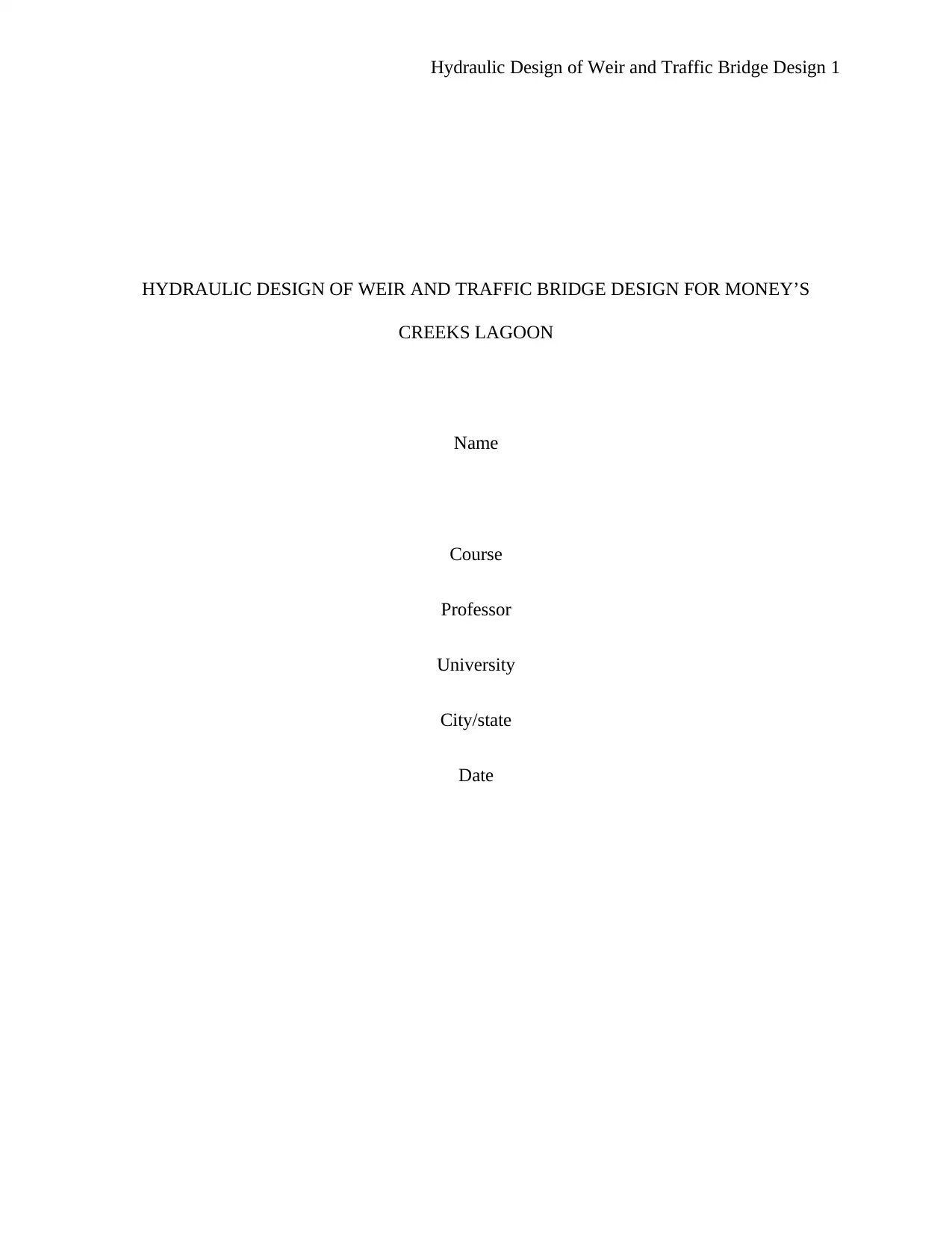
Hydraulic Design of Weir and Traffic Bridge Design 1
HYDRAULIC DESIGN OF WEIR AND TRAFFIC BRIDGE DESIGN FOR MONEY’S
CREEKS LAGOON
Name
Course
Professor
University
City/state
Date
HYDRAULIC DESIGN OF WEIR AND TRAFFIC BRIDGE DESIGN FOR MONEY’S
CREEKS LAGOON
Name
Course
Professor
University
City/state
Date
Secure Best Marks with AI Grader
Need help grading? Try our AI Grader for instant feedback on your assignments.
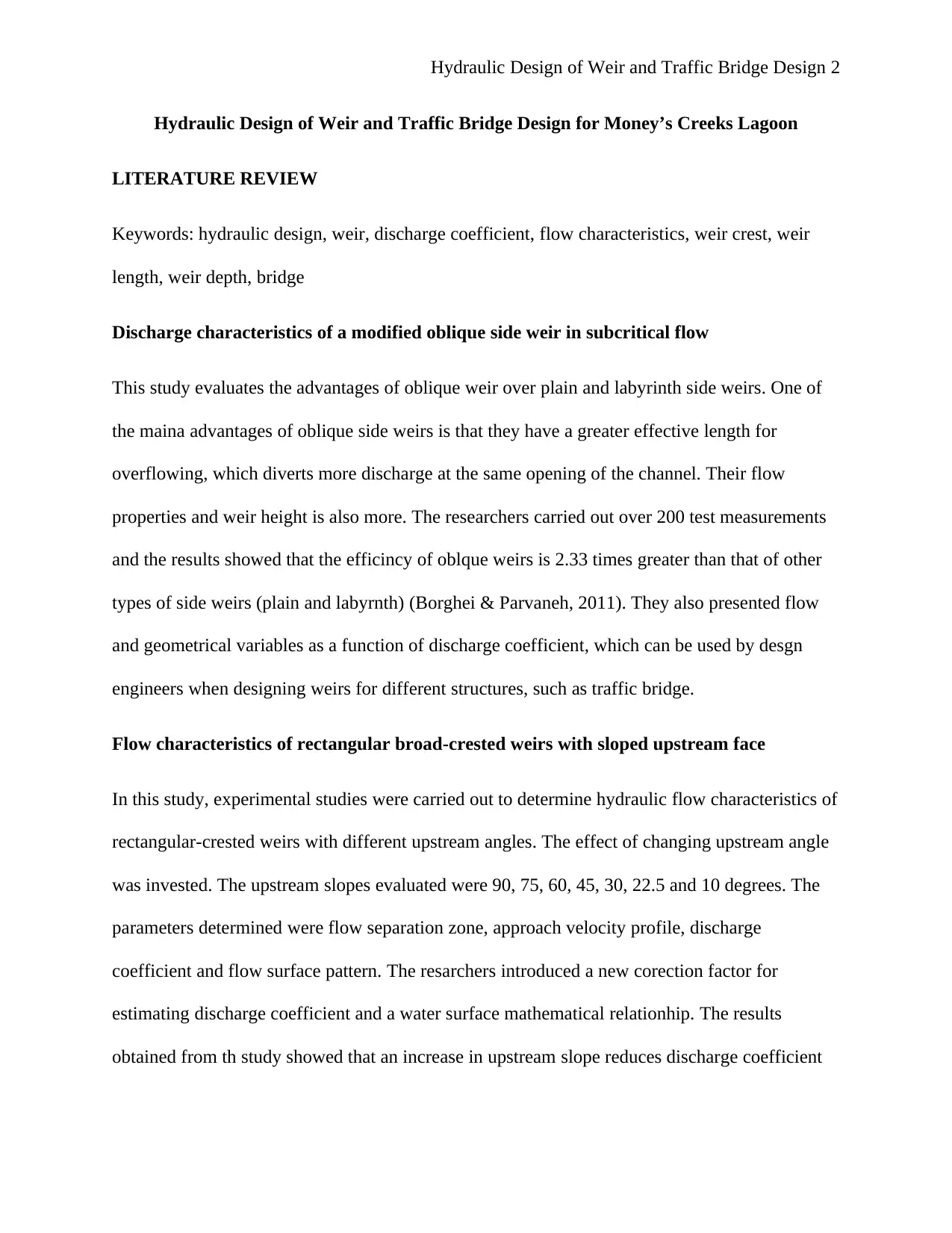
Hydraulic Design of Weir and Traffic Bridge Design 2
Hydraulic Design of Weir and Traffic Bridge Design for Money’s Creeks Lagoon
LITERATURE REVIEW
Keywords: hydraulic design, weir, discharge coefficient, flow characteristics, weir crest, weir
length, weir depth, bridge
Discharge characteristics of a modified oblique side weir in subcritical flow
This study evaluates the advantages of oblique weir over plain and labyrinth side weirs. One of
the maina advantages of oblique side weirs is that they have a greater effective length for
overflowing, which diverts more discharge at the same opening of the channel. Their flow
properties and weir height is also more. The researchers carried out over 200 test measurements
and the results showed that the efficincy of oblque weirs is 2.33 times greater than that of other
types of side weirs (plain and labyrnth) (Borghei & Parvaneh, 2011). They also presented flow
and geometrical variables as a function of discharge coefficient, which can be used by desgn
engineers when designing weirs for different structures, such as traffic bridge.
Flow characteristics of rectangular broad-crested weirs with sloped upstream face
In this study, experimental studies were carried out to determine hydraulic flow characteristics of
rectangular-crested weirs with different upstream angles. The effect of changing upstream angle
was invested. The upstream slopes evaluated were 90, 75, 60, 45, 30, 22.5 and 10 degrees. The
parameters determined were flow separation zone, approach velocity profile, discharge
coefficient and flow surface pattern. The resarchers introduced a new corection factor for
estimating discharge coefficient and a water surface mathematical relationhip. The results
obtained from th study showed that an increase in upstream slope reduces discharge coefficient
Hydraulic Design of Weir and Traffic Bridge Design for Money’s Creeks Lagoon
LITERATURE REVIEW
Keywords: hydraulic design, weir, discharge coefficient, flow characteristics, weir crest, weir
length, weir depth, bridge
Discharge characteristics of a modified oblique side weir in subcritical flow
This study evaluates the advantages of oblique weir over plain and labyrinth side weirs. One of
the maina advantages of oblique side weirs is that they have a greater effective length for
overflowing, which diverts more discharge at the same opening of the channel. Their flow
properties and weir height is also more. The researchers carried out over 200 test measurements
and the results showed that the efficincy of oblque weirs is 2.33 times greater than that of other
types of side weirs (plain and labyrnth) (Borghei & Parvaneh, 2011). They also presented flow
and geometrical variables as a function of discharge coefficient, which can be used by desgn
engineers when designing weirs for different structures, such as traffic bridge.
Flow characteristics of rectangular broad-crested weirs with sloped upstream face
In this study, experimental studies were carried out to determine hydraulic flow characteristics of
rectangular-crested weirs with different upstream angles. The effect of changing upstream angle
was invested. The upstream slopes evaluated were 90, 75, 60, 45, 30, 22.5 and 10 degrees. The
parameters determined were flow separation zone, approach velocity profile, discharge
coefficient and flow surface pattern. The resarchers introduced a new corection factor for
estimating discharge coefficient and a water surface mathematical relationhip. The results
obtained from th study showed that an increase in upstream slope reduces discharge coefficient
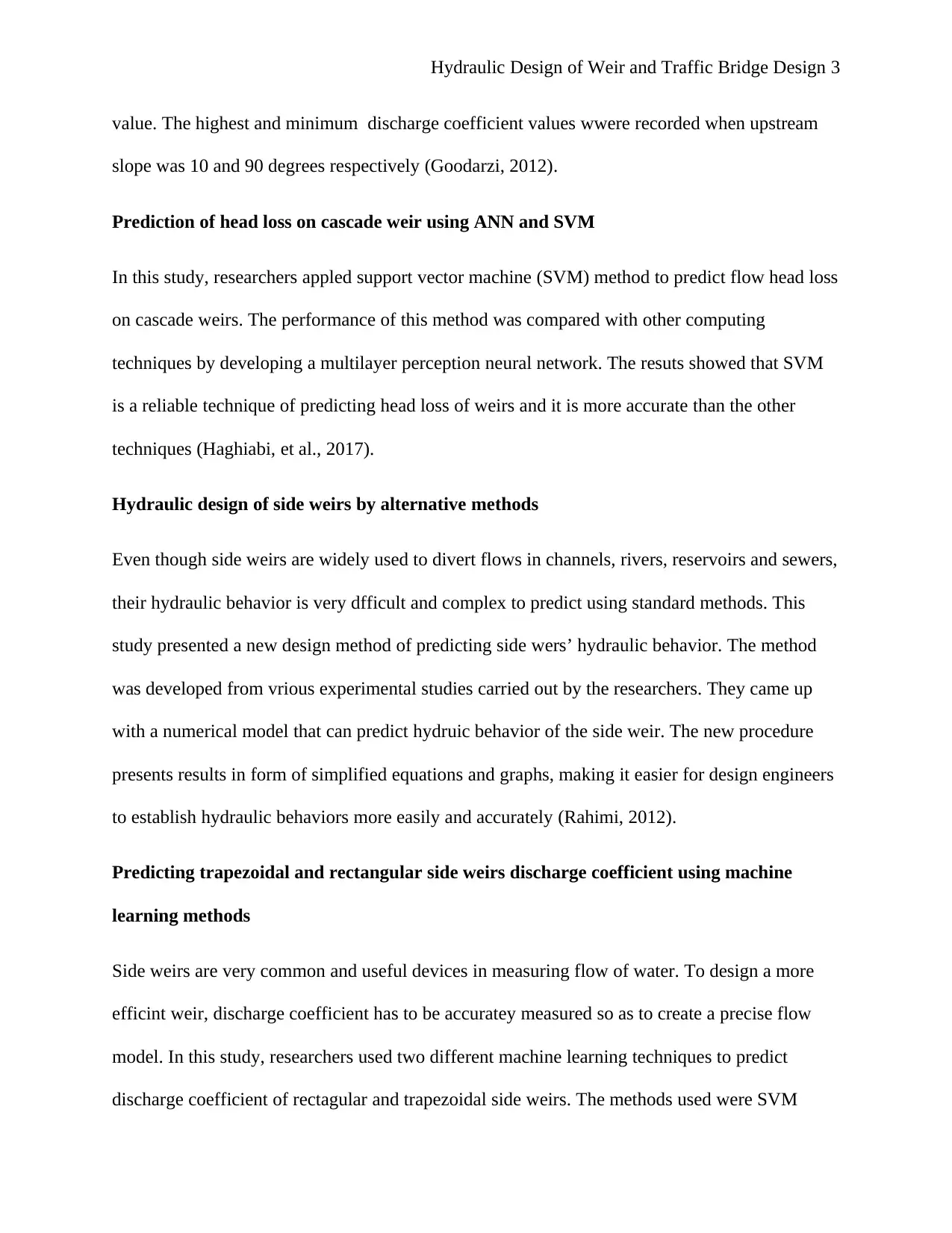
Hydraulic Design of Weir and Traffic Bridge Design 3
value. The highest and minimum discharge coefficient values wwere recorded when upstream
slope was 10 and 90 degrees respectively (Goodarzi, 2012).
Prediction of head loss on cascade weir using ANN and SVM
In this study, researchers appled support vector machine (SVM) method to predict flow head loss
on cascade weirs. The performance of this method was compared with other computing
techniques by developing a multilayer perception neural network. The resuts showed that SVM
is a reliable technique of predicting head loss of weirs and it is more accurate than the other
techniques (Haghiabi, et al., 2017).
Hydraulic design of side weirs by alternative methods
Even though side weirs are widely used to divert flows in channels, rivers, reservoirs and sewers,
their hydraulic behavior is very dfficult and complex to predict using standard methods. This
study presented a new design method of predicting side wers’ hydraulic behavior. The method
was developed from vrious experimental studies carried out by the researchers. They came up
with a numerical model that can predict hydruic behavior of the side weir. The new procedure
presents results in form of simplified equations and graphs, making it easier for design engineers
to establish hydraulic behaviors more easily and accurately (Rahimi, 2012).
Predicting trapezoidal and rectangular side weirs discharge coefficient using machine
learning methods
Side weirs are very common and useful devices in measuring flow of water. To design a more
efficint weir, discharge coefficient has to be accuratey measured so as to create a precise flow
model. In this study, researchers used two different machine learning techniques to predict
discharge coefficient of rectagular and trapezoidal side weirs. The methods used were SVM
value. The highest and minimum discharge coefficient values wwere recorded when upstream
slope was 10 and 90 degrees respectively (Goodarzi, 2012).
Prediction of head loss on cascade weir using ANN and SVM
In this study, researchers appled support vector machine (SVM) method to predict flow head loss
on cascade weirs. The performance of this method was compared with other computing
techniques by developing a multilayer perception neural network. The resuts showed that SVM
is a reliable technique of predicting head loss of weirs and it is more accurate than the other
techniques (Haghiabi, et al., 2017).
Hydraulic design of side weirs by alternative methods
Even though side weirs are widely used to divert flows in channels, rivers, reservoirs and sewers,
their hydraulic behavior is very dfficult and complex to predict using standard methods. This
study presented a new design method of predicting side wers’ hydraulic behavior. The method
was developed from vrious experimental studies carried out by the researchers. They came up
with a numerical model that can predict hydruic behavior of the side weir. The new procedure
presents results in form of simplified equations and graphs, making it easier for design engineers
to establish hydraulic behaviors more easily and accurately (Rahimi, 2012).
Predicting trapezoidal and rectangular side weirs discharge coefficient using machine
learning methods
Side weirs are very common and useful devices in measuring flow of water. To design a more
efficint weir, discharge coefficient has to be accuratey measured so as to create a precise flow
model. In this study, researchers used two different machine learning techniques to predict
discharge coefficient of rectagular and trapezoidal side weirs. The methods used were SVM
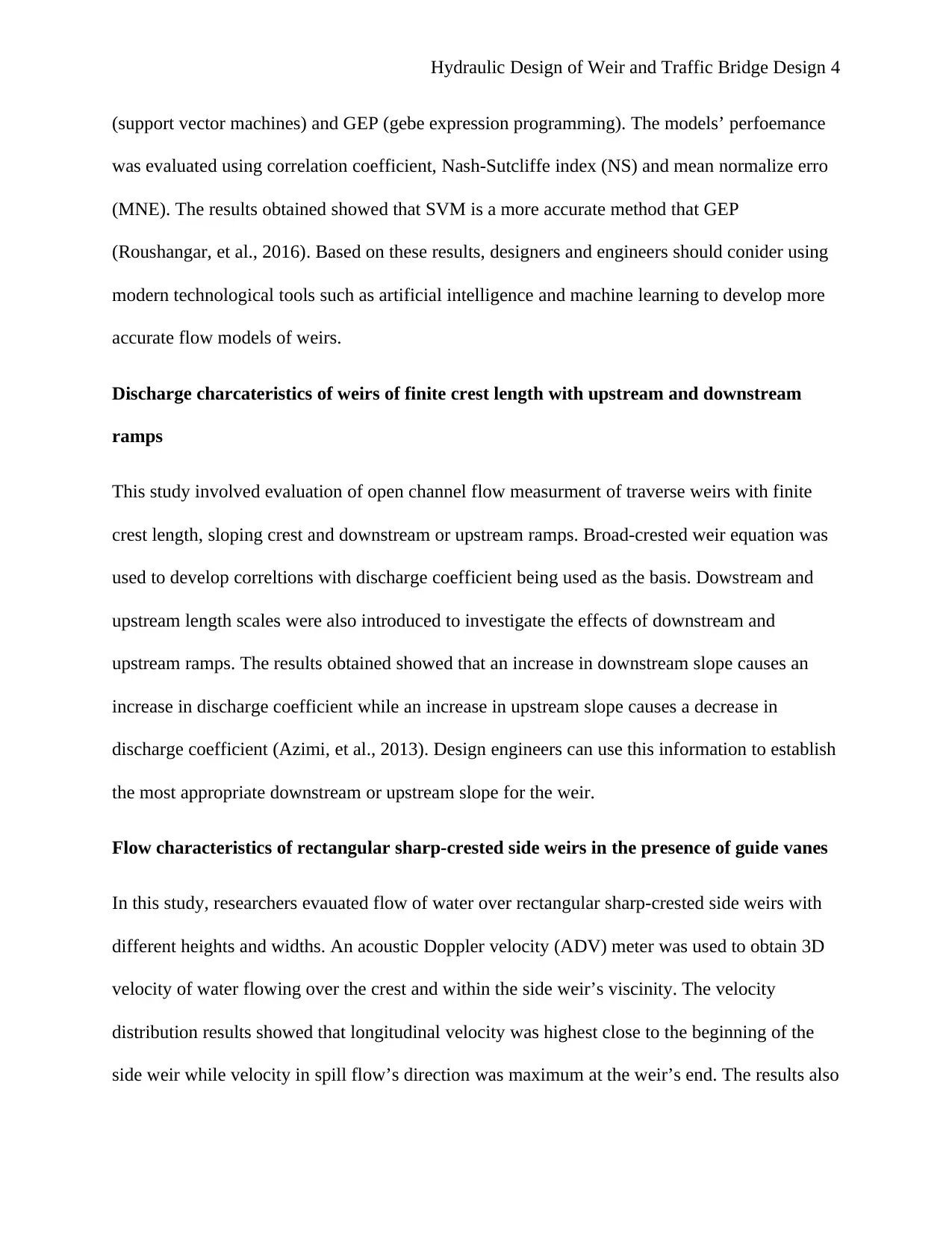
Hydraulic Design of Weir and Traffic Bridge Design 4
(support vector machines) and GEP (gebe expression programming). The models’ perfoemance
was evaluated using correlation coefficient, Nash-Sutcliffe index (NS) and mean normalize erro
(MNE). The results obtained showed that SVM is a more accurate method that GEP
(Roushangar, et al., 2016). Based on these results, designers and engineers should conider using
modern technological tools such as artificial intelligence and machine learning to develop more
accurate flow models of weirs.
Discharge charcateristics of weirs of finite crest length with upstream and downstream
ramps
This study involved evaluation of open channel flow measurment of traverse weirs with finite
crest length, sloping crest and downstream or upstream ramps. Broad-crested weir equation was
used to develop correltions with discharge coefficient being used as the basis. Dowstream and
upstream length scales were also introduced to investigate the effects of downstream and
upstream ramps. The results obtained showed that an increase in downstream slope causes an
increase in discharge coefficient while an increase in upstream slope causes a decrease in
discharge coefficient (Azimi, et al., 2013). Design engineers can use this information to establish
the most appropriate downstream or upstream slope for the weir.
Flow characteristics of rectangular sharp-crested side weirs in the presence of guide vanes
In this study, researchers evauated flow of water over rectangular sharp-crested side weirs with
different heights and widths. An acoustic Doppler velocity (ADV) meter was used to obtain 3D
velocity of water flowing over the crest and within the side weir’s viscinity. The velocity
distribution results showed that longitudinal velocity was highest close to the beginning of the
side weir while velocity in spill flow’s direction was maximum at the weir’s end. The results also
(support vector machines) and GEP (gebe expression programming). The models’ perfoemance
was evaluated using correlation coefficient, Nash-Sutcliffe index (NS) and mean normalize erro
(MNE). The results obtained showed that SVM is a more accurate method that GEP
(Roushangar, et al., 2016). Based on these results, designers and engineers should conider using
modern technological tools such as artificial intelligence and machine learning to develop more
accurate flow models of weirs.
Discharge charcateristics of weirs of finite crest length with upstream and downstream
ramps
This study involved evaluation of open channel flow measurment of traverse weirs with finite
crest length, sloping crest and downstream or upstream ramps. Broad-crested weir equation was
used to develop correltions with discharge coefficient being used as the basis. Dowstream and
upstream length scales were also introduced to investigate the effects of downstream and
upstream ramps. The results obtained showed that an increase in downstream slope causes an
increase in discharge coefficient while an increase in upstream slope causes a decrease in
discharge coefficient (Azimi, et al., 2013). Design engineers can use this information to establish
the most appropriate downstream or upstream slope for the weir.
Flow characteristics of rectangular sharp-crested side weirs in the presence of guide vanes
In this study, researchers evauated flow of water over rectangular sharp-crested side weirs with
different heights and widths. An acoustic Doppler velocity (ADV) meter was used to obtain 3D
velocity of water flowing over the crest and within the side weir’s viscinity. The velocity
distribution results showed that longitudinal velocity was highest close to the beginning of the
side weir while velocity in spill flow’s direction was maximum at the weir’s end. The results also
Secure Best Marks with AI Grader
Need help grading? Try our AI Grader for instant feedback on your assignments.
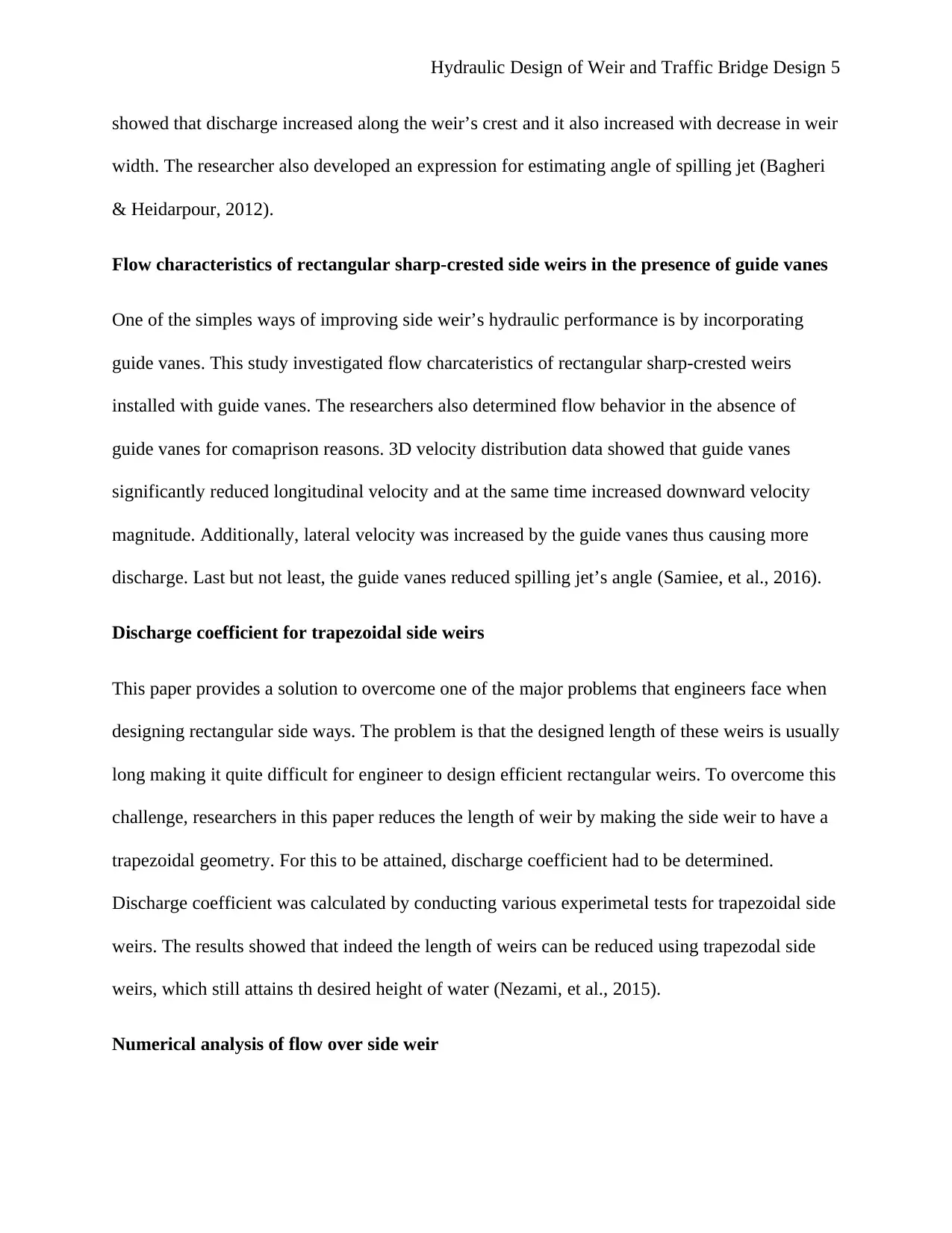
Hydraulic Design of Weir and Traffic Bridge Design 5
showed that discharge increased along the weir’s crest and it also increased with decrease in weir
width. The researcher also developed an expression for estimating angle of spilling jet (Bagheri
& Heidarpour, 2012).
Flow characteristics of rectangular sharp-crested side weirs in the presence of guide vanes
One of the simples ways of improving side weir’s hydraulic performance is by incorporating
guide vanes. This study investigated flow charcateristics of rectangular sharp-crested weirs
installed with guide vanes. The researchers also determined flow behavior in the absence of
guide vanes for comaprison reasons. 3D velocity distribution data showed that guide vanes
significantly reduced longitudinal velocity and at the same time increased downward velocity
magnitude. Additionally, lateral velocity was increased by the guide vanes thus causing more
discharge. Last but not least, the guide vanes reduced spilling jet’s angle (Samiee, et al., 2016).
Discharge coefficient for trapezoidal side weirs
This paper provides a solution to overcome one of the major problems that engineers face when
designing rectangular side ways. The problem is that the designed length of these weirs is usually
long making it quite difficult for engineer to design efficient rectangular weirs. To overcome this
challenge, researchers in this paper reduces the length of weir by making the side weir to have a
trapezoidal geometry. For this to be attained, discharge coefficient had to be determined.
Discharge coefficient was calculated by conducting various experimetal tests for trapezoidal side
weirs. The results showed that indeed the length of weirs can be reduced using trapezodal side
weirs, which still attains th desired height of water (Nezami, et al., 2015).
Numerical analysis of flow over side weir
showed that discharge increased along the weir’s crest and it also increased with decrease in weir
width. The researcher also developed an expression for estimating angle of spilling jet (Bagheri
& Heidarpour, 2012).
Flow characteristics of rectangular sharp-crested side weirs in the presence of guide vanes
One of the simples ways of improving side weir’s hydraulic performance is by incorporating
guide vanes. This study investigated flow charcateristics of rectangular sharp-crested weirs
installed with guide vanes. The researchers also determined flow behavior in the absence of
guide vanes for comaprison reasons. 3D velocity distribution data showed that guide vanes
significantly reduced longitudinal velocity and at the same time increased downward velocity
magnitude. Additionally, lateral velocity was increased by the guide vanes thus causing more
discharge. Last but not least, the guide vanes reduced spilling jet’s angle (Samiee, et al., 2016).
Discharge coefficient for trapezoidal side weirs
This paper provides a solution to overcome one of the major problems that engineers face when
designing rectangular side ways. The problem is that the designed length of these weirs is usually
long making it quite difficult for engineer to design efficient rectangular weirs. To overcome this
challenge, researchers in this paper reduces the length of weir by making the side weir to have a
trapezoidal geometry. For this to be attained, discharge coefficient had to be determined.
Discharge coefficient was calculated by conducting various experimetal tests for trapezoidal side
weirs. The results showed that indeed the length of weirs can be reduced using trapezodal side
weirs, which still attains th desired height of water (Nezami, et al., 2015).
Numerical analysis of flow over side weir
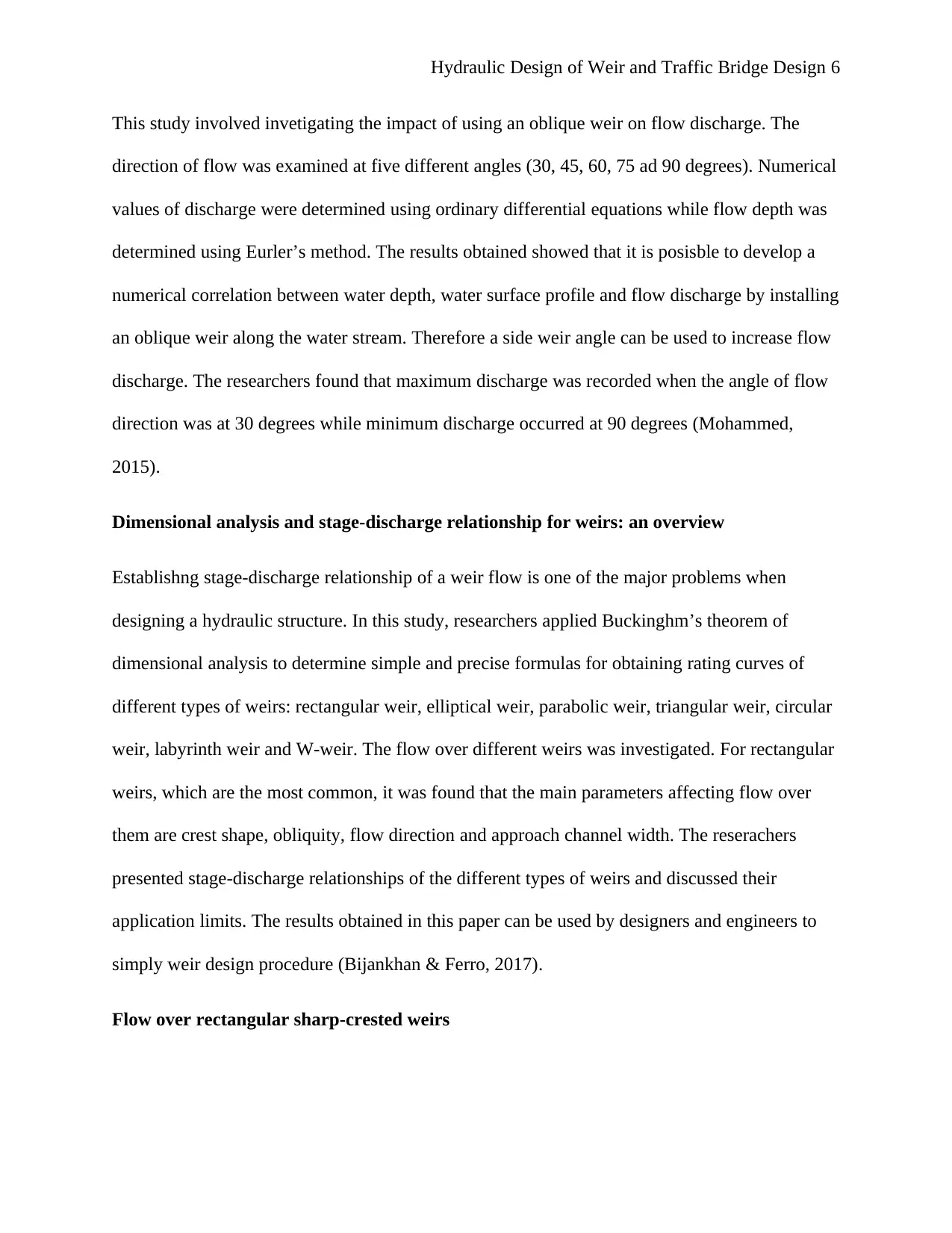
Hydraulic Design of Weir and Traffic Bridge Design 6
This study involved invetigating the impact of using an oblique weir on flow discharge. The
direction of flow was examined at five different angles (30, 45, 60, 75 ad 90 degrees). Numerical
values of discharge were determined using ordinary differential equations while flow depth was
determined using Eurler’s method. The results obtained showed that it is posisble to develop a
numerical correlation between water depth, water surface profile and flow discharge by installing
an oblique weir along the water stream. Therefore a side weir angle can be used to increase flow
discharge. The researchers found that maximum discharge was recorded when the angle of flow
direction was at 30 degrees while minimum discharge occurred at 90 degrees (Mohammed,
2015).
Dimensional analysis and stage-discharge relationship for weirs: an overview
Establishng stage-discharge relationship of a weir flow is one of the major problems when
designing a hydraulic structure. In this study, researchers applied Buckinghm’s theorem of
dimensional analysis to determine simple and precise formulas for obtaining rating curves of
different types of weirs: rectangular weir, elliptical weir, parabolic weir, triangular weir, circular
weir, labyrinth weir and W-weir. The flow over different weirs was investigated. For rectangular
weirs, which are the most common, it was found that the main parameters affecting flow over
them are crest shape, obliquity, flow direction and approach channel width. The reserachers
presented stage-discharge relationships of the different types of weirs and discussed their
application limits. The results obtained in this paper can be used by designers and engineers to
simply weir design procedure (Bijankhan & Ferro, 2017).
Flow over rectangular sharp-crested weirs
This study involved invetigating the impact of using an oblique weir on flow discharge. The
direction of flow was examined at five different angles (30, 45, 60, 75 ad 90 degrees). Numerical
values of discharge were determined using ordinary differential equations while flow depth was
determined using Eurler’s method. The results obtained showed that it is posisble to develop a
numerical correlation between water depth, water surface profile and flow discharge by installing
an oblique weir along the water stream. Therefore a side weir angle can be used to increase flow
discharge. The researchers found that maximum discharge was recorded when the angle of flow
direction was at 30 degrees while minimum discharge occurred at 90 degrees (Mohammed,
2015).
Dimensional analysis and stage-discharge relationship for weirs: an overview
Establishng stage-discharge relationship of a weir flow is one of the major problems when
designing a hydraulic structure. In this study, researchers applied Buckinghm’s theorem of
dimensional analysis to determine simple and precise formulas for obtaining rating curves of
different types of weirs: rectangular weir, elliptical weir, parabolic weir, triangular weir, circular
weir, labyrinth weir and W-weir. The flow over different weirs was investigated. For rectangular
weirs, which are the most common, it was found that the main parameters affecting flow over
them are crest shape, obliquity, flow direction and approach channel width. The reserachers
presented stage-discharge relationships of the different types of weirs and discussed their
application limits. The results obtained in this paper can be used by designers and engineers to
simply weir design procedure (Bijankhan & Ferro, 2017).
Flow over rectangular sharp-crested weirs
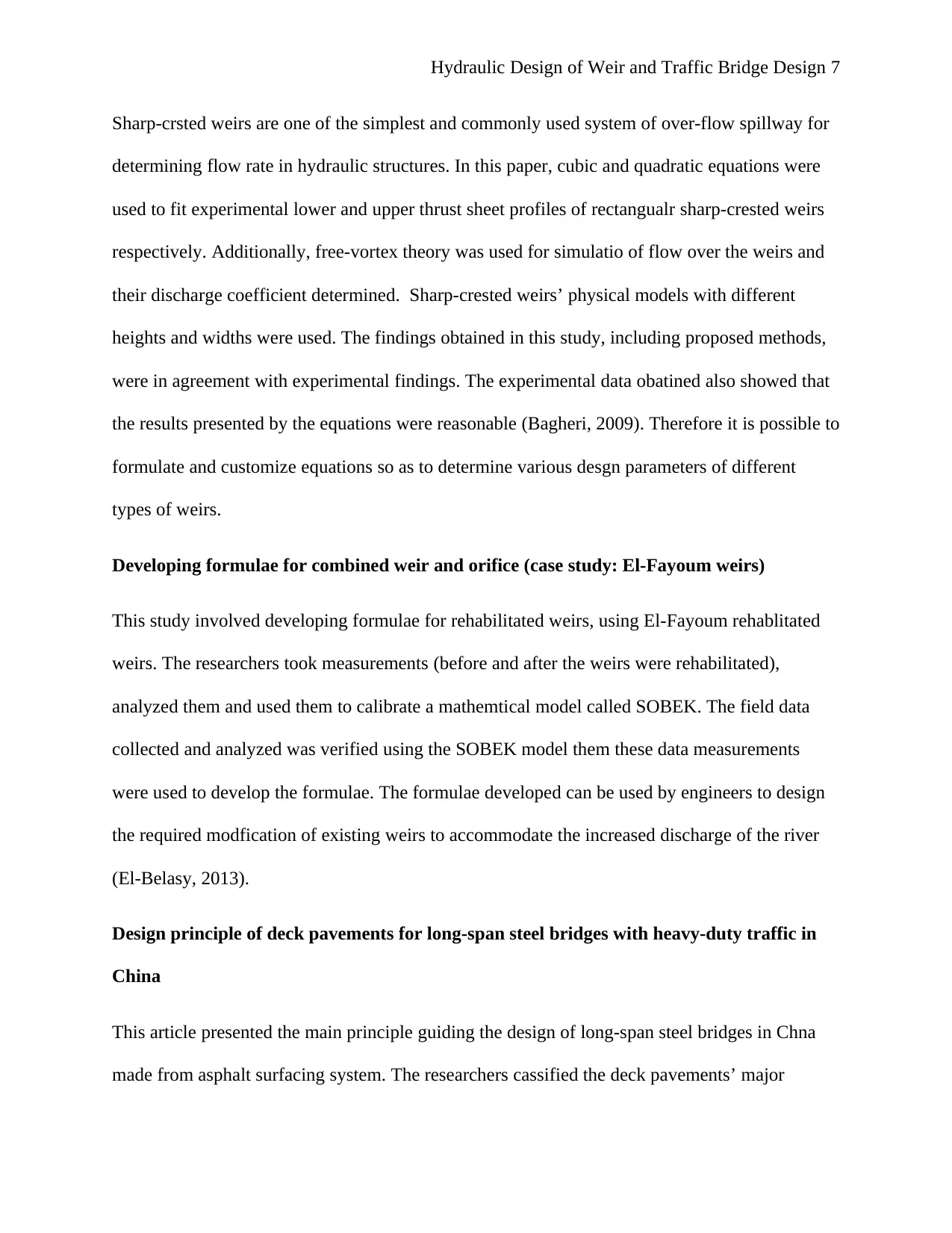
Hydraulic Design of Weir and Traffic Bridge Design 7
Sharp-crsted weirs are one of the simplest and commonly used system of over-flow spillway for
determining flow rate in hydraulic structures. In this paper, cubic and quadratic equations were
used to fit experimental lower and upper thrust sheet profiles of rectangualr sharp-crested weirs
respectively. Additionally, free-vortex theory was used for simulatio of flow over the weirs and
their discharge coefficient determined. Sharp-crested weirs’ physical models with different
heights and widths were used. The findings obtained in this study, including proposed methods,
were in agreement with experimental findings. The experimental data obatined also showed that
the results presented by the equations were reasonable (Bagheri, 2009). Therefore it is possible to
formulate and customize equations so as to determine various desgn parameters of different
types of weirs.
Developing formulae for combined weir and orifice (case study: El-Fayoum weirs)
This study involved developing formulae for rehabilitated weirs, using El-Fayoum rehablitated
weirs. The researchers took measurements (before and after the weirs were rehabilitated),
analyzed them and used them to calibrate a mathemtical model called SOBEK. The field data
collected and analyzed was verified using the SOBEK model them these data measurements
were used to develop the formulae. The formulae developed can be used by engineers to design
the required modfication of existing weirs to accommodate the increased discharge of the river
(El-Belasy, 2013).
Design principle of deck pavements for long-span steel bridges with heavy-duty traffic in
China
This article presented the main principle guiding the design of long-span steel bridges in Chna
made from asphalt surfacing system. The researchers cassified the deck pavements’ major
Sharp-crsted weirs are one of the simplest and commonly used system of over-flow spillway for
determining flow rate in hydraulic structures. In this paper, cubic and quadratic equations were
used to fit experimental lower and upper thrust sheet profiles of rectangualr sharp-crested weirs
respectively. Additionally, free-vortex theory was used for simulatio of flow over the weirs and
their discharge coefficient determined. Sharp-crested weirs’ physical models with different
heights and widths were used. The findings obtained in this study, including proposed methods,
were in agreement with experimental findings. The experimental data obatined also showed that
the results presented by the equations were reasonable (Bagheri, 2009). Therefore it is possible to
formulate and customize equations so as to determine various desgn parameters of different
types of weirs.
Developing formulae for combined weir and orifice (case study: El-Fayoum weirs)
This study involved developing formulae for rehabilitated weirs, using El-Fayoum rehablitated
weirs. The researchers took measurements (before and after the weirs were rehabilitated),
analyzed them and used them to calibrate a mathemtical model called SOBEK. The field data
collected and analyzed was verified using the SOBEK model them these data measurements
were used to develop the formulae. The formulae developed can be used by engineers to design
the required modfication of existing weirs to accommodate the increased discharge of the river
(El-Belasy, 2013).
Design principle of deck pavements for long-span steel bridges with heavy-duty traffic in
China
This article presented the main principle guiding the design of long-span steel bridges in Chna
made from asphalt surfacing system. The researchers cassified the deck pavements’ major
Paraphrase This Document
Need a fresh take? Get an instant paraphrase of this document with our AI Paraphraser
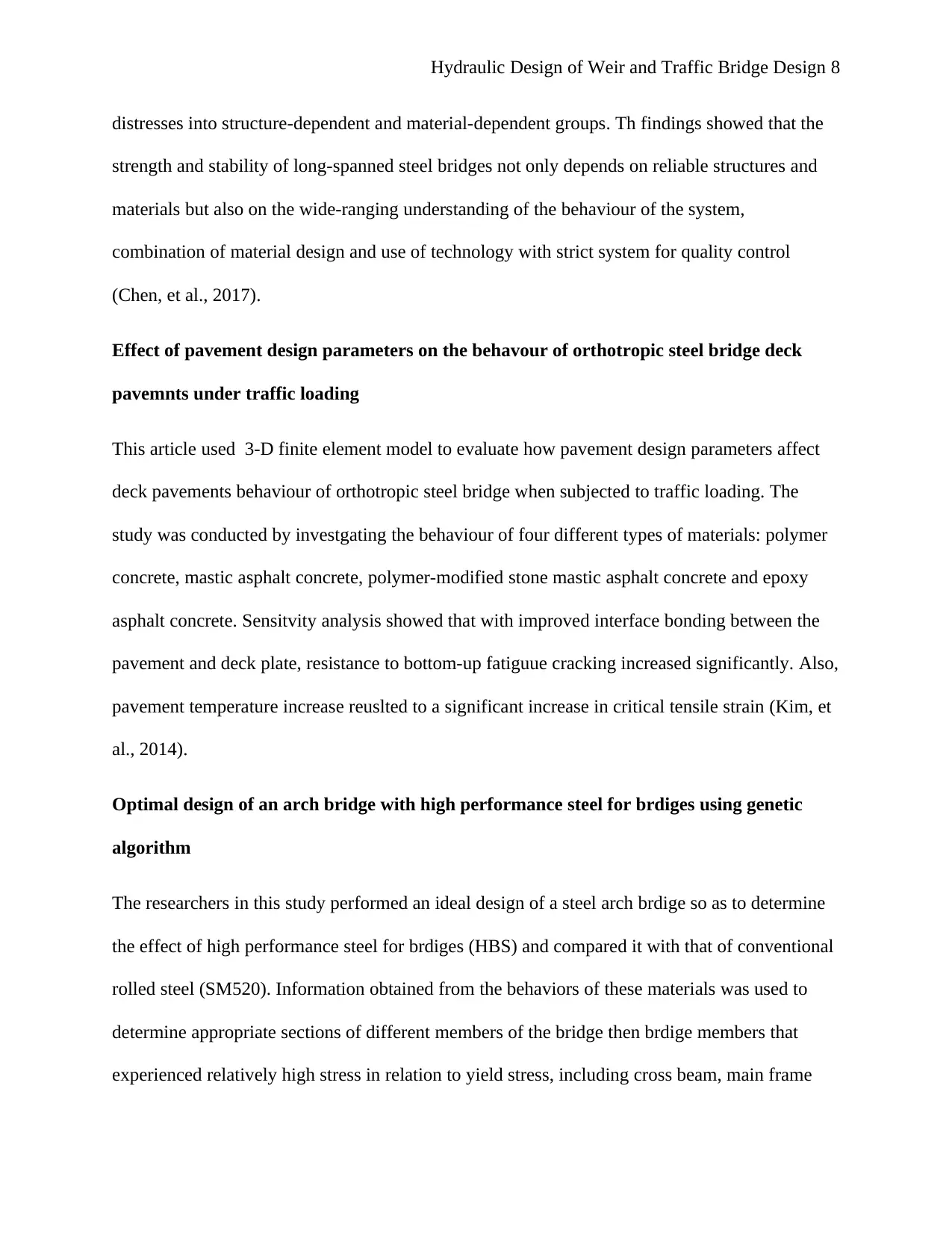
Hydraulic Design of Weir and Traffic Bridge Design 8
distresses into structure-dependent and material-dependent groups. Th findings showed that the
strength and stability of long-spanned steel bridges not only depends on reliable structures and
materials but also on the wide-ranging understanding of the behaviour of the system,
combination of material design and use of technology with strict system for quality control
(Chen, et al., 2017).
Effect of pavement design parameters on the behavour of orthotropic steel bridge deck
pavemnts under traffic loading
This article used 3-D finite element model to evaluate how pavement design parameters affect
deck pavements behaviour of orthotropic steel bridge when subjected to traffic loading. The
study was conducted by investgating the behaviour of four different types of materials: polymer
concrete, mastic asphalt concrete, polymer-modified stone mastic asphalt concrete and epoxy
asphalt concrete. Sensitvity analysis showed that with improved interface bonding between the
pavement and deck plate, resistance to bottom-up fatiguue cracking increased significantly. Also,
pavement temperature increase reuslted to a significant increase in critical tensile strain (Kim, et
al., 2014).
Optimal design of an arch bridge with high performance steel for brdiges using genetic
algorithm
The researchers in this study performed an ideal design of a steel arch brdige so as to determine
the effect of high performance steel for brdiges (HBS) and compared it with that of conventional
rolled steel (SM520). Information obtained from the behaviors of these materials was used to
determine appropriate sections of different members of the bridge then brdige members that
experienced relatively high stress in relation to yield stress, including cross beam, main frame
distresses into structure-dependent and material-dependent groups. Th findings showed that the
strength and stability of long-spanned steel bridges not only depends on reliable structures and
materials but also on the wide-ranging understanding of the behaviour of the system,
combination of material design and use of technology with strict system for quality control
(Chen, et al., 2017).
Effect of pavement design parameters on the behavour of orthotropic steel bridge deck
pavemnts under traffic loading
This article used 3-D finite element model to evaluate how pavement design parameters affect
deck pavements behaviour of orthotropic steel bridge when subjected to traffic loading. The
study was conducted by investgating the behaviour of four different types of materials: polymer
concrete, mastic asphalt concrete, polymer-modified stone mastic asphalt concrete and epoxy
asphalt concrete. Sensitvity analysis showed that with improved interface bonding between the
pavement and deck plate, resistance to bottom-up fatiguue cracking increased significantly. Also,
pavement temperature increase reuslted to a significant increase in critical tensile strain (Kim, et
al., 2014).
Optimal design of an arch bridge with high performance steel for brdiges using genetic
algorithm
The researchers in this study performed an ideal design of a steel arch brdige so as to determine
the effect of high performance steel for brdiges (HBS) and compared it with that of conventional
rolled steel (SM520). Information obtained from the behaviors of these materials was used to
determine appropriate sections of different members of the bridge then brdige members that
experienced relatively high stress in relation to yield stress, including cross beam, main frame
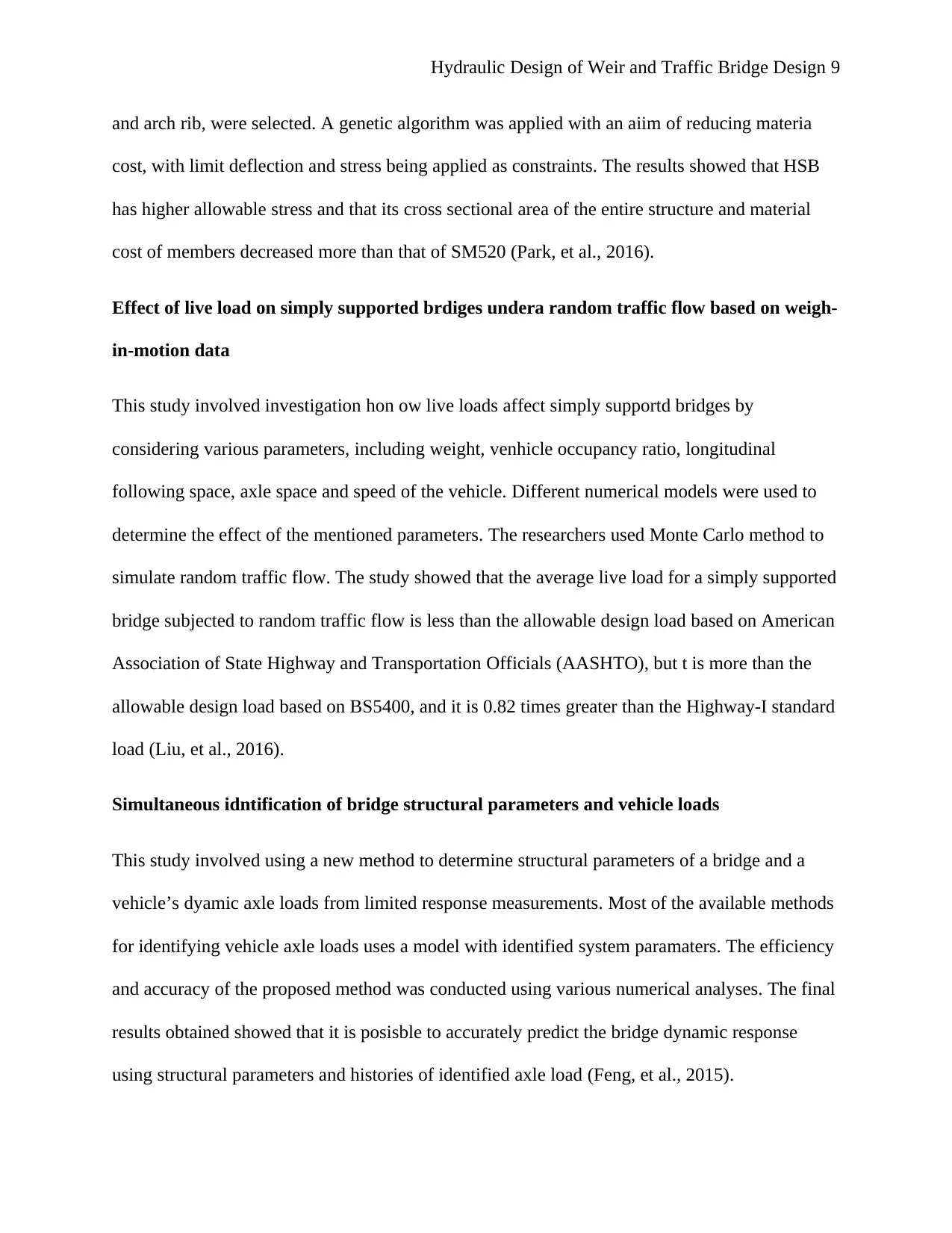
Hydraulic Design of Weir and Traffic Bridge Design 9
and arch rib, were selected. A genetic algorithm was applied with an aiim of reducing materia
cost, with limit deflection and stress being applied as constraints. The results showed that HSB
has higher allowable stress and that its cross sectional area of the entire structure and material
cost of members decreased more than that of SM520 (Park, et al., 2016).
Effect of live load on simply supported brdiges undera random traffic flow based on weigh-
in-motion data
This study involved investigation hon ow live loads affect simply supportd bridges by
considering various parameters, including weight, venhicle occupancy ratio, longitudinal
following space, axle space and speed of the vehicle. Different numerical models were used to
determine the effect of the mentioned parameters. The researchers used Monte Carlo method to
simulate random traffic flow. The study showed that the average live load for a simply supported
bridge subjected to random traffic flow is less than the allowable design load based on American
Association of State Highway and Transportation Officials (AASHTO), but t is more than the
allowable design load based on BS5400, and it is 0.82 times greater than the Highway-I standard
load (Liu, et al., 2016).
Simultaneous idntification of bridge structural parameters and vehicle loads
This study involved using a new method to determine structural parameters of a bridge and a
vehicle’s dyamic axle loads from limited response measurements. Most of the available methods
for identifying vehicle axle loads uses a model with identified system paramaters. The efficiency
and accuracy of the proposed method was conducted using various numerical analyses. The final
results obtained showed that it is posisble to accurately predict the bridge dynamic response
using structural parameters and histories of identified axle load (Feng, et al., 2015).
and arch rib, were selected. A genetic algorithm was applied with an aiim of reducing materia
cost, with limit deflection and stress being applied as constraints. The results showed that HSB
has higher allowable stress and that its cross sectional area of the entire structure and material
cost of members decreased more than that of SM520 (Park, et al., 2016).
Effect of live load on simply supported brdiges undera random traffic flow based on weigh-
in-motion data
This study involved investigation hon ow live loads affect simply supportd bridges by
considering various parameters, including weight, venhicle occupancy ratio, longitudinal
following space, axle space and speed of the vehicle. Different numerical models were used to
determine the effect of the mentioned parameters. The researchers used Monte Carlo method to
simulate random traffic flow. The study showed that the average live load for a simply supported
bridge subjected to random traffic flow is less than the allowable design load based on American
Association of State Highway and Transportation Officials (AASHTO), but t is more than the
allowable design load based on BS5400, and it is 0.82 times greater than the Highway-I standard
load (Liu, et al., 2016).
Simultaneous idntification of bridge structural parameters and vehicle loads
This study involved using a new method to determine structural parameters of a bridge and a
vehicle’s dyamic axle loads from limited response measurements. Most of the available methods
for identifying vehicle axle loads uses a model with identified system paramaters. The efficiency
and accuracy of the proposed method was conducted using various numerical analyses. The final
results obtained showed that it is posisble to accurately predict the bridge dynamic response
using structural parameters and histories of identified axle load (Feng, et al., 2015).
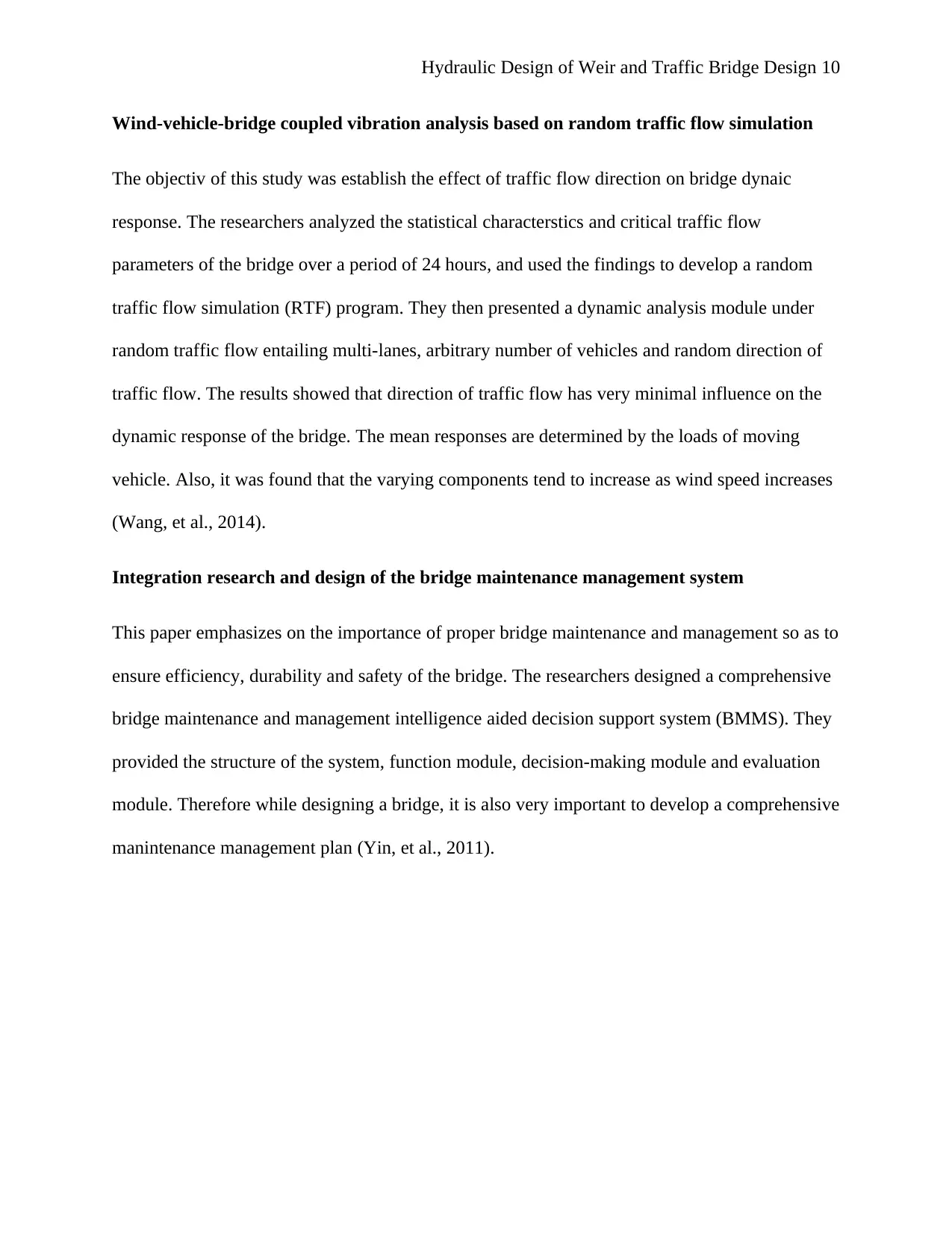
Hydraulic Design of Weir and Traffic Bridge Design 10
Wind-vehicle-bridge coupled vibration analysis based on random traffic flow simulation
The objectiv of this study was establish the effect of traffic flow direction on bridge dynaic
response. The researchers analyzed the statistical characterstics and critical traffic flow
parameters of the bridge over a period of 24 hours, and used the findings to develop a random
traffic flow simulation (RTF) program. They then presented a dynamic analysis module under
random traffic flow entailing multi-lanes, arbitrary number of vehicles and random direction of
traffic flow. The results showed that direction of traffic flow has very minimal influence on the
dynamic response of the bridge. The mean responses are determined by the loads of moving
vehicle. Also, it was found that the varying components tend to increase as wind speed increases
(Wang, et al., 2014).
Integration research and design of the bridge maintenance management system
This paper emphasizes on the importance of proper bridge maintenance and management so as to
ensure efficiency, durability and safety of the bridge. The researchers designed a comprehensive
bridge maintenance and management intelligence aided decision support system (BMMS). They
provided the structure of the system, function module, decision-making module and evaluation
module. Therefore while designing a bridge, it is also very important to develop a comprehensive
manintenance management plan (Yin, et al., 2011).
Wind-vehicle-bridge coupled vibration analysis based on random traffic flow simulation
The objectiv of this study was establish the effect of traffic flow direction on bridge dynaic
response. The researchers analyzed the statistical characterstics and critical traffic flow
parameters of the bridge over a period of 24 hours, and used the findings to develop a random
traffic flow simulation (RTF) program. They then presented a dynamic analysis module under
random traffic flow entailing multi-lanes, arbitrary number of vehicles and random direction of
traffic flow. The results showed that direction of traffic flow has very minimal influence on the
dynamic response of the bridge. The mean responses are determined by the loads of moving
vehicle. Also, it was found that the varying components tend to increase as wind speed increases
(Wang, et al., 2014).
Integration research and design of the bridge maintenance management system
This paper emphasizes on the importance of proper bridge maintenance and management so as to
ensure efficiency, durability and safety of the bridge. The researchers designed a comprehensive
bridge maintenance and management intelligence aided decision support system (BMMS). They
provided the structure of the system, function module, decision-making module and evaluation
module. Therefore while designing a bridge, it is also very important to develop a comprehensive
manintenance management plan (Yin, et al., 2011).
Secure Best Marks with AI Grader
Need help grading? Try our AI Grader for instant feedback on your assignments.
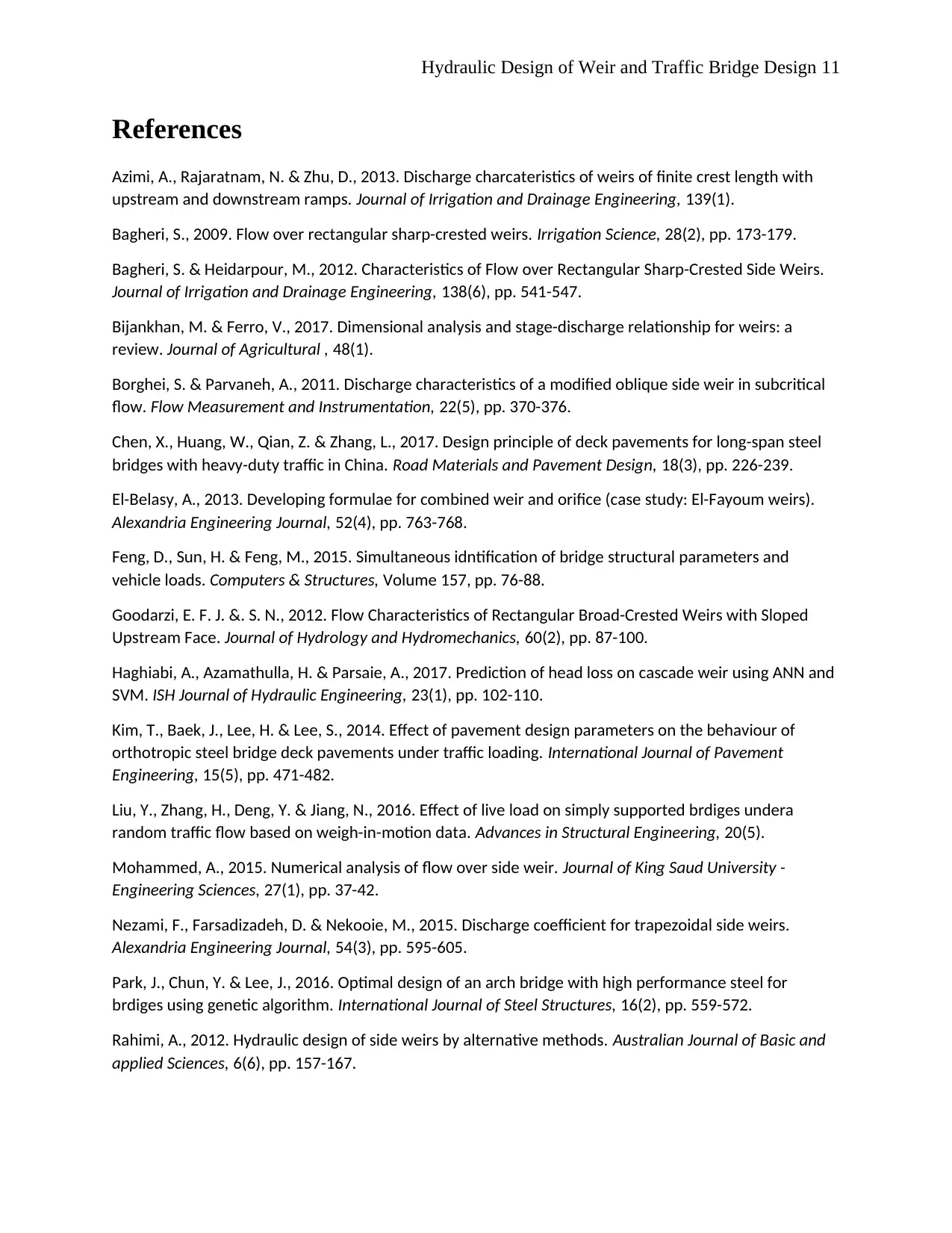
Hydraulic Design of Weir and Traffic Bridge Design 11
References
Azimi, A., Rajaratnam, N. & Zhu, D., 2013. Discharge charcateristics of weirs of finite crest length with
upstream and downstream ramps. Journal of Irrigation and Drainage Engineering, 139(1).
Bagheri, S., 2009. Flow over rectangular sharp-crested weirs. Irrigation Science, 28(2), pp. 173-179.
Bagheri, S. & Heidarpour, M., 2012. Characteristics of Flow over Rectangular Sharp-Crested Side Weirs.
Journal of Irrigation and Drainage Engineering, 138(6), pp. 541-547.
Bijankhan, M. & Ferro, V., 2017. Dimensional analysis and stage-discharge relationship for weirs: a
review. Journal of Agricultural , 48(1).
Borghei, S. & Parvaneh, A., 2011. Discharge characteristics of a modified oblique side weir in subcritical
flow. Flow Measurement and Instrumentation, 22(5), pp. 370-376.
Chen, X., Huang, W., Qian, Z. & Zhang, L., 2017. Design principle of deck pavements for long-span steel
bridges with heavy-duty traffic in China. Road Materials and Pavement Design, 18(3), pp. 226-239.
El-Belasy, A., 2013. Developing formulae for combined weir and orifice (case study: El-Fayoum weirs).
Alexandria Engineering Journal, 52(4), pp. 763-768.
Feng, D., Sun, H. & Feng, M., 2015. Simultaneous idntification of bridge structural parameters and
vehicle loads. Computers & Structures, Volume 157, pp. 76-88.
Goodarzi, E. F. J. &. S. N., 2012. Flow Characteristics of Rectangular Broad-Crested Weirs with Sloped
Upstream Face. Journal of Hydrology and Hydromechanics, 60(2), pp. 87-100.
Haghiabi, A., Azamathulla, H. & Parsaie, A., 2017. Prediction of head loss on cascade weir using ANN and
SVM. ISH Journal of Hydraulic Engineering, 23(1), pp. 102-110.
Kim, T., Baek, J., Lee, H. & Lee, S., 2014. Effect of pavement design parameters on the behaviour of
orthotropic steel bridge deck pavements under traffic loading. International Journal of Pavement
Engineering, 15(5), pp. 471-482.
Liu, Y., Zhang, H., Deng, Y. & Jiang, N., 2016. Effect of live load on simply supported brdiges undera
random traffic flow based on weigh-in-motion data. Advances in Structural Engineering, 20(5).
Mohammed, A., 2015. Numerical analysis of flow over side weir. Journal of King Saud University -
Engineering Sciences, 27(1), pp. 37-42.
Nezami, F., Farsadizadeh, D. & Nekooie, M., 2015. Discharge coefficient for trapezoidal side weirs.
Alexandria Engineering Journal, 54(3), pp. 595-605.
Park, J., Chun, Y. & Lee, J., 2016. Optimal design of an arch bridge with high performance steel for
brdiges using genetic algorithm. International Journal of Steel Structures, 16(2), pp. 559-572.
Rahimi, A., 2012. Hydraulic design of side weirs by alternative methods. Australian Journal of Basic and
applied Sciences, 6(6), pp. 157-167.
References
Azimi, A., Rajaratnam, N. & Zhu, D., 2013. Discharge charcateristics of weirs of finite crest length with
upstream and downstream ramps. Journal of Irrigation and Drainage Engineering, 139(1).
Bagheri, S., 2009. Flow over rectangular sharp-crested weirs. Irrigation Science, 28(2), pp. 173-179.
Bagheri, S. & Heidarpour, M., 2012. Characteristics of Flow over Rectangular Sharp-Crested Side Weirs.
Journal of Irrigation and Drainage Engineering, 138(6), pp. 541-547.
Bijankhan, M. & Ferro, V., 2017. Dimensional analysis and stage-discharge relationship for weirs: a
review. Journal of Agricultural , 48(1).
Borghei, S. & Parvaneh, A., 2011. Discharge characteristics of a modified oblique side weir in subcritical
flow. Flow Measurement and Instrumentation, 22(5), pp. 370-376.
Chen, X., Huang, W., Qian, Z. & Zhang, L., 2017. Design principle of deck pavements for long-span steel
bridges with heavy-duty traffic in China. Road Materials and Pavement Design, 18(3), pp. 226-239.
El-Belasy, A., 2013. Developing formulae for combined weir and orifice (case study: El-Fayoum weirs).
Alexandria Engineering Journal, 52(4), pp. 763-768.
Feng, D., Sun, H. & Feng, M., 2015. Simultaneous idntification of bridge structural parameters and
vehicle loads. Computers & Structures, Volume 157, pp. 76-88.
Goodarzi, E. F. J. &. S. N., 2012. Flow Characteristics of Rectangular Broad-Crested Weirs with Sloped
Upstream Face. Journal of Hydrology and Hydromechanics, 60(2), pp. 87-100.
Haghiabi, A., Azamathulla, H. & Parsaie, A., 2017. Prediction of head loss on cascade weir using ANN and
SVM. ISH Journal of Hydraulic Engineering, 23(1), pp. 102-110.
Kim, T., Baek, J., Lee, H. & Lee, S., 2014. Effect of pavement design parameters on the behaviour of
orthotropic steel bridge deck pavements under traffic loading. International Journal of Pavement
Engineering, 15(5), pp. 471-482.
Liu, Y., Zhang, H., Deng, Y. & Jiang, N., 2016. Effect of live load on simply supported brdiges undera
random traffic flow based on weigh-in-motion data. Advances in Structural Engineering, 20(5).
Mohammed, A., 2015. Numerical analysis of flow over side weir. Journal of King Saud University -
Engineering Sciences, 27(1), pp. 37-42.
Nezami, F., Farsadizadeh, D. & Nekooie, M., 2015. Discharge coefficient for trapezoidal side weirs.
Alexandria Engineering Journal, 54(3), pp. 595-605.
Park, J., Chun, Y. & Lee, J., 2016. Optimal design of an arch bridge with high performance steel for
brdiges using genetic algorithm. International Journal of Steel Structures, 16(2), pp. 559-572.
Rahimi, A., 2012. Hydraulic design of side weirs by alternative methods. Australian Journal of Basic and
applied Sciences, 6(6), pp. 157-167.
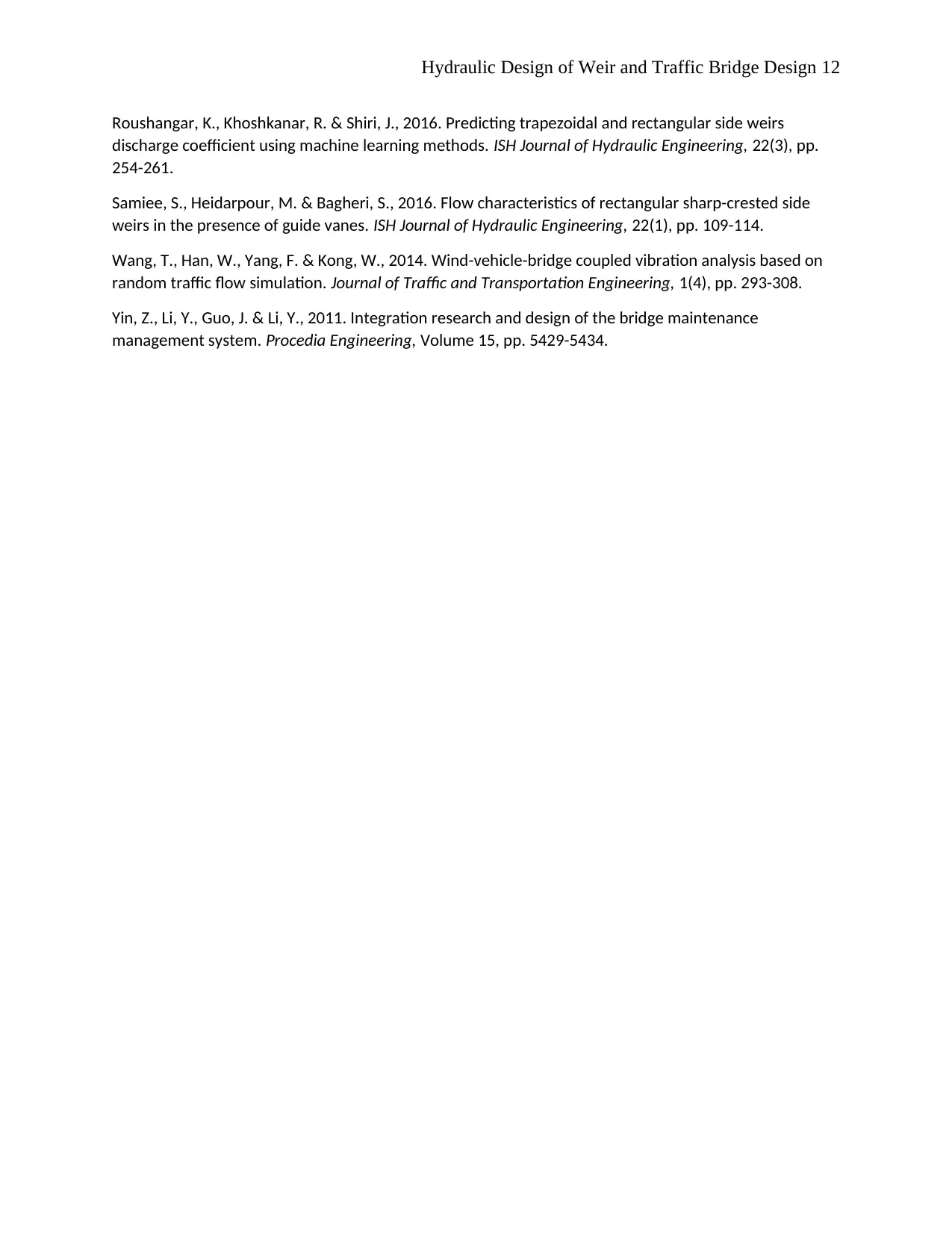
Hydraulic Design of Weir and Traffic Bridge Design 12
Roushangar, K., Khoshkanar, R. & Shiri, J., 2016. Predicting trapezoidal and rectangular side weirs
discharge coefficient using machine learning methods. ISH Journal of Hydraulic Engineering, 22(3), pp.
254-261.
Samiee, S., Heidarpour, M. & Bagheri, S., 2016. Flow characteristics of rectangular sharp-crested side
weirs in the presence of guide vanes. ISH Journal of Hydraulic Engineering, 22(1), pp. 109-114.
Wang, T., Han, W., Yang, F. & Kong, W., 2014. Wind-vehicle-bridge coupled vibration analysis based on
random traffic flow simulation. Journal of Traffic and Transportation Engineering, 1(4), pp. 293-308.
Yin, Z., Li, Y., Guo, J. & Li, Y., 2011. Integration research and design of the bridge maintenance
management system. Procedia Engineering, Volume 15, pp. 5429-5434.
Roushangar, K., Khoshkanar, R. & Shiri, J., 2016. Predicting trapezoidal and rectangular side weirs
discharge coefficient using machine learning methods. ISH Journal of Hydraulic Engineering, 22(3), pp.
254-261.
Samiee, S., Heidarpour, M. & Bagheri, S., 2016. Flow characteristics of rectangular sharp-crested side
weirs in the presence of guide vanes. ISH Journal of Hydraulic Engineering, 22(1), pp. 109-114.
Wang, T., Han, W., Yang, F. & Kong, W., 2014. Wind-vehicle-bridge coupled vibration analysis based on
random traffic flow simulation. Journal of Traffic and Transportation Engineering, 1(4), pp. 293-308.
Yin, Z., Li, Y., Guo, J. & Li, Y., 2011. Integration research and design of the bridge maintenance
management system. Procedia Engineering, Volume 15, pp. 5429-5434.
1 out of 12
Your All-in-One AI-Powered Toolkit for Academic Success.
+13062052269
info@desklib.com
Available 24*7 on WhatsApp / Email
![[object Object]](/_next/static/media/star-bottom.7253800d.svg)
Unlock your academic potential
© 2024 | Zucol Services PVT LTD | All rights reserved.